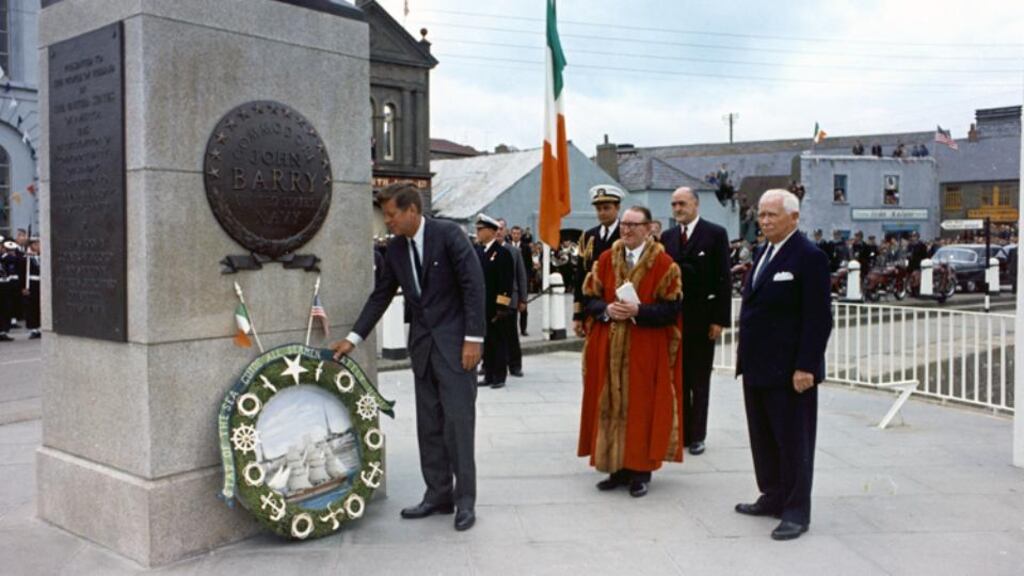If the winner of the title "Father of the United States navy" were to be judged on embellished tales of derring- do, then Scottish-born John Paul Jones would surely sink Irish-born John Barry without trace.
In terms of monuments, parks and other public commemorations though, Barry is fighting back. Today, the Commodore John Barry Memorial, a 2.5m-high granite sculpture at the US Naval Academy at Annapolis in Mary- land, 50km east of Washington DC, will be dedicated at a special ceremony.
The debate about who played a more significant role in the establishment of the US navy has raged for decades, pitting the native of Tacumshane near Wexford town against the man born in Kirkbean in Kirkcudbrightshire, Scotland, with expat Irish and Scots rowing in behind their compatriots.
Both were skilled seamen who fought and won many battles during the American Revolution, though Jones’s swashbuckling adventures are more frequently recounted as he took the fight to the crown.
Jones's riposte to a royal navy captain who in 1779, the fourth year of the American War of Independence, called for the surrender of his warship USS Bonhomme Richard is inscribed into his monument on the hallowed National Mall in Washington. "I have not yet begun to fight," he reputedly said. Barry's monument stands on less revered ground, 10 blocks north on Franklin Square, near the White House.
"They were both elegant mariners and shrewd warriors," said Tim McGrath, author of the 2010 book John Barry: an American hero in the Age of Sail, who will speak at today's dedication ceremony.
"But Jones was his own best press agent. Congress was always after the other captains to file reporters. Nobody had to ask Jones to do that. His reports came with complaints about what Congress should be doing and even with poetry. Barry was a lot more taciturn."
Contrasting personalities
The sharply contrasting personalities may explain why Jones has overshadowed Barry in the telling of American history. Barry's supporters like to point out that George Washington, the first US president, made the Wexford- born sailor the country's first commissioned naval officer and bestowed the title of commodore on him. Every new officer in the US navy being commissioned takes a number after Barry as commissioned officer number one.
They note that Jones left the US after the War of Independence to live in France whereas Barry remained to serve presidents Washington, John Adams and Thomas Jefferson as head of the navy. Barry's flagship, the USS United States, served as the first naval academy, producing many heroes of the undeclared war against the French between 1798 and 1800 and the War of 1812 with Britain.
One prominent resident of Annapolis, Maryland governor Martin O'Malley, said he had seen the courage of naval officers near the governor's mansion, citing the legacy left by Barry.
“I cannot extol the virtue and importance of our country’s naval skills enough, and much of our success is due to Commodore John Barry,” he said in a letter for the programme on the memorial dedication, in which he described Barry as “the father of the modern American navy”.
In his homeland Barry is commemorated with a statue at Crescent Quay in Wexford where in 1963 another naval hero and emigrant son of Wexford, John F Kennedy, laid a wreath. Even though he was just a teenager when he left Wexford as a cabin boy on a merchant ship, making Philadelphia his adopted home, Barry remained proud of his Irish roots.
Soft touch
"He never forgot them," said McGrath. "He was constantly besieged from home with letters from family, all of whom were close to or destitute. He never failed to provide whatever they needed monetarily. He was known as a soft touch for anyone coming from Ireland. "
Barry, who had no children of his own, helped raise Michael and Patrick Hayes, children of his sister Eleanor and her husband Thomas who died in Ireland in the 1780s.
The new memorial to Barry is the culmination of almost a decade of efforts by the Ancient Order of Hibernians (AOH) and in particular by two members of its Washington DC division, John McInerney and Jack O’Brien. McInerney died unexpectedly in his sleep this week at the age of 74, just days before the formal dedication of the monument. O’Brien spoke proudly of his friend’s “amazing work”.
The two men, along with the AOH divisions and other Irish- American groups across the US, raised more than $200,000 (€144,000) to build the monument. It will be located on Barry Plaza, just inside the pedestrian gate to the US naval academy that was named after Barry in 2012.
The monuments are the fruit of years of trying to have the Wexford man recognised for the influence he had on the navy. The new memorial will help confirm his position as father of the US navy.
“It is certainly not going to hurt,” said McGrath.












